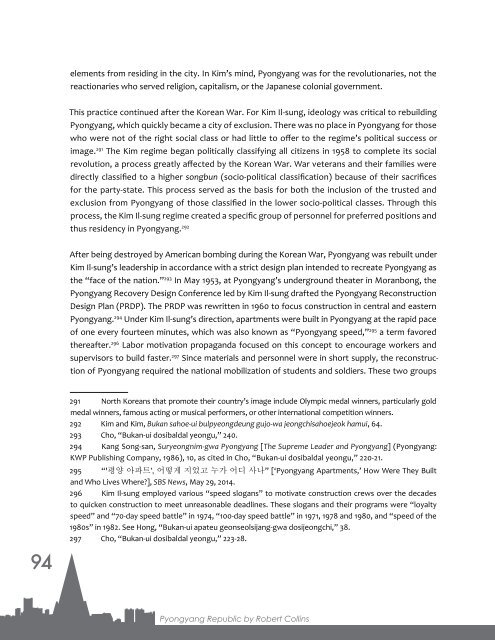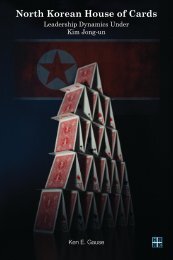REPUBLIC
Collins_PyongyangRepublic_FINAL_WEB
Collins_PyongyangRepublic_FINAL_WEB
You also want an ePaper? Increase the reach of your titles
YUMPU automatically turns print PDFs into web optimized ePapers that Google loves.
elements from residing in the city. In Kim’s mind, Pyongyang was for the revolutionaries, not the<br />
reactionaries who served religion, capitalism, or the Japanese colonial government.<br />
This practice continued after the Korean War. For Kim Il-sung, ideology was critical to rebuilding<br />
Pyongyang, which quickly became a city of exclusion. There was no place in Pyongyang for those<br />
who were not of the right social class or had little to offer to the regime’s political success or<br />
image. 291 The Kim regime began politically classifying all citizens in 1958 to complete its social<br />
revolution, a process greatly affected by the Korean War. War veterans and their families were<br />
directly classified to a higher songbun (socio-political classification) because of their sacrifices<br />
for the party-state. This process served as the basis for both the inclusion of the trusted and<br />
exclusion from Pyongyang of those classified in the lower socio-political classes. Through this<br />
process, the Kim Il-sung regime created a specific group of personnel for preferred positions and<br />
thus residency in Pyongyang. 292<br />
After being destroyed by American bombing during the Korean War, Pyongyang was rebuilt under<br />
Kim Il-sung’s leadership in accordance with a strict design plan intended to recreate Pyongyang as<br />
the “face of the nation.” 293 In May 1953, at Pyongyang’s underground theater in Moranbong, the<br />
Pyongyang Recovery Design Conference led by Kim Il-sung drafted the Pyongyang Reconstruction<br />
Design Plan (PRDP). The PRDP was rewritten in 1960 to focus construction in central and eastern<br />
Pyongyang. 294 Under Kim Il-sung’s direction, apartments were built in Pyongyang at the rapid pace<br />
of one every fourteen minutes, which was also known as “Pyongyang speed,” 295 a term favored<br />
thereafter. 296 Labor motivation propaganda focused on this concept to encourage workers and<br />
supervisors to build faster. 297 Since materials and personnel were in short supply, the reconstruction<br />
of Pyongyang required the national mobilization of students and soldiers. These two groups<br />
291 North Koreans that promote their country’s image include Olympic medal winners, particularly gold<br />
medal winners, famous acting or musical performers, or other international competition winners.<br />
292 Kim and Kim, Bukan sahoe-ui bulpyeongdeung gujo-wa jeongchisahoejeok hamui, 64.<br />
293 Cho, “Bukan-ui dosibaldal yeongu,” 240.<br />
294 Kang Song-san, Suryeongnim-gwa Pyongyang [The Supreme Leader and Pyongyang] (Pyongyang:<br />
KWP Publishing Company, 1986), 10, as cited in Cho, “Bukan-ui dosibaldal yeongu,” 220-21.<br />
295 “'평양 아파트', 어떻게 지었고 누가 어디 사나” [‘Pyongyang Apartments,’ How Were They Built<br />
and Who Lives Where?], SBS News, May 29, 2014.<br />
296 Kim Il-sung employed various “speed slogans” to motivate construction crews over the decades<br />
to quicken construction to meet unreasonable deadlines. These slogans and their programs were “loyalty<br />
speed” and “70-day speed battle” in 1974, “100-day speed battle” in 1971, 1978 and 1980, and “speed of the<br />
1980s” in 1982. See Hong, “Bukan-ui apateu geonseolsijang-gwa dosijeongchi,” 38.<br />
297 Cho, “Bukan-ui dosibaldal yeongu,” 223-28.<br />
94<br />
Pyongyang Republic by Robert Collins



